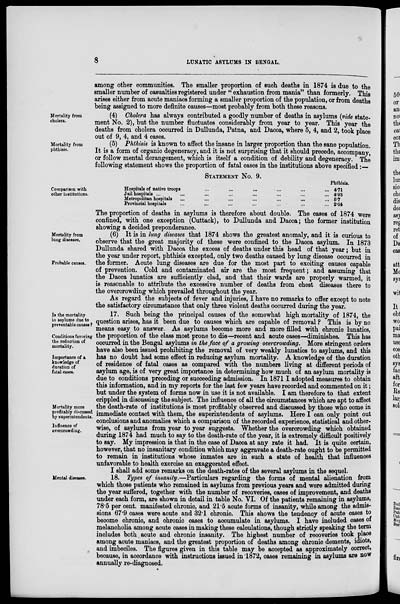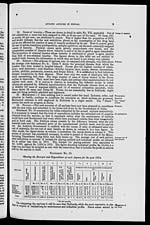Medicine - Mental health > 1867-1924 - Annual report of the insane asylums in Bengal > Insane asylums in Bengal annual reports 1867-1875 > Annual report on the insane asylums in Bengal for the year 1874
(798) Page 8
Download files
Individual page:
Thumbnail gallery: Grid view | List view

8 LUNATIC ASYLUMS IN BENGAL.
among other communities. The smaller proportion of such deaths in 1874 is due to the
smaller number of casualties registered under " exhaustion from mania" than formerly. This
arises either from acute maniacs forming a smaller proportion of the population, or from deaths
being assigned to more definite causes—most probably from both these reasons.
Mortality from
cholera.
(4) Cholera has always contributed a goodly number of deaths in asylums (vide state-
ment No. 2), but the number fluctuates considerably from year to year. This year the
deaths from cholera occurred in Dullunda, Patna, and Dacca, where 5, 4, and 2, took place
out of 9, 4, and 4 cases.
Mortality from
phthisis.
(5) Phthisis is known to affect the insane in larger proportion than the sane population.
It is a form of organic degeneracy, and it is not surprising that it should precede, accompany,
or follow mental derangement, which is itself a condition of debility and degeneracy. The
following statement shows the proportion of fatal cases in the institutions above specified :—
Comparison with
other institutions.
STATEMENT No. 9.
|
Phthisis. |
|
|
Hospitals of native troops ... ... ... ... ... ... ... |
4.71 |
|
Jail hospitals ... ... ... ... ... ... ... ... |
4.93 |
|
Metropolitan hospitals ... ... ... ... ... ... ... |
5.7 |
|
Provincial hospitals ... ... ... ... ... ... ... |
2.04 |
The proportion of deaths in asylums is therefore about double. The cases of 1874 were
confined, with one exception (Cuttack), to Dullunda and Dacca; the former institution
showing a decided preponderance.
Mortality from
lung diseases.
Probable causes.
(6) It is in lung diseases that 1874 shows the greatest anomaly, and it is curious to
observe that the great majority of these were confined to the Dacca asylum. In 1873
Dullunda shared with Dacca the excess of deaths under this head of that year; but in
the year under report, phthisis excepted, only two deaths caused by lung disease occurred in
the former. Acute lung diseases are due for the most part to exciting causes capable
of prevention. Cold and contaminated air are the most frequent; and assuming that
the Dacca lunatics are sufficiently clad, and that their wards are properly warmed, it
is reasonable to attribute the excessive number of deaths from chest diseases there to
the overcrowding which prevailed throughout the year.
As regard the subjects of fever and injuries, I have no remarks to offer except to note
the satisfactory circumstance that only three violent deaths occurred during the year.
Is the mortality
in asylums due to
preventable causes ?
Conditions favoring
the reduction of
mortality.
Importance of a
knowledge of
duration of
fatal cases.
Mortality more
profitably discussed
by superintendents.
Influence of
overcrowding.
17. Such being the principal causes of the somewhat high mortality of 1874, the
question arises, has it been due to causes which are capable of removal ? This is by no
means easy to answer. As asylums become more and more filled with chronic lunatics,
the proportion of the class most prone to die—recent and acute cases—diminishes. This has
occurred in the Bengal asylums in the face of a growing overcrowding. More stringent orders
have also been issued prohibiting the removal of very weakly lunatics to asylums, and this
has no doubt had some effect in reducing asylum mortality. A knowledge of the duration
of residence of fatal cases as compared with the numbers living at different periods of
asylum age, is of very great importance in determining how much of an asylum mortality is
due to conditions preceding or succeeding admission. In 1871 I adopted measures to obtain
this information, and in my reports for the last few years have recorded and commented on it;
but under the system of forms now in use it is not available. I am therefore to that extent
crippled in discussing the subject. The influence of all the circumstances which are apt to affect
the death-rate of institutions is most profitably observed and discussed by those who come in
immediate contact with them, the superintendents of asylums. Here I can only point out
conclusions and anomalies which a comparison of the recorded experience, statistical and other-
wise, of asylums from year to year suggests. Whether the overcrowding which obtained
during 1874 had much to say to the death-rate of the year, it is extremely difficult positively
to say. My impression is that in the case of Dacca at any rate it had. It is quite certain,
however, that no insanitary condition which may aggravate a death-rate ought to be permitted
to remain in institutions whose inmates are in such a state of health that influences
unfavorable to health exercise an exaggerated effect.
I shall add some remarks on the death-rates of the several asylums in the sequel.
Mental diseases.
18. Types of insanity.—Particulars regarding the forms of mental alienation from
which those patients who remained in asylums from previous years and were admitted during
the year suffered, together with the number of recoveries, cases of improvement, and deaths
under each form, are shown in detail in table No. VI. Of the patients remaining in asylums,
78.5 per cent. manifested chronic, and 21.5 acute forms of insanity, while among the admis-
sions 67.9 cases were acute and 32.1 chronic This shows the tendency of acute cases to
become chronic, and chronic cases to accumulate in asylums. I have included cases of
melancholia among acute cases in making these calculations, though strictly speaking the term
includes both acute and chronic insanity. The highest number of recoveries took place
among acute maniacs, and the greatest proportion of deaths among chronic dements, idiots,
and imbeciles. The figures given in this table may be accepted as approximately correct,
because, in accordance with instructions issued in 1872, cases remaining in asylums are now
annually re-diagnosed.
Set display mode to: Large image | Zoom image | Transcription
Images and transcriptions on this page, including medium image downloads, may be used under the Creative Commons Attribution 4.0 International Licence unless otherwise stated. ![]()
| Permanent URL | https://digital.nls.uk/83380394 |
|---|




